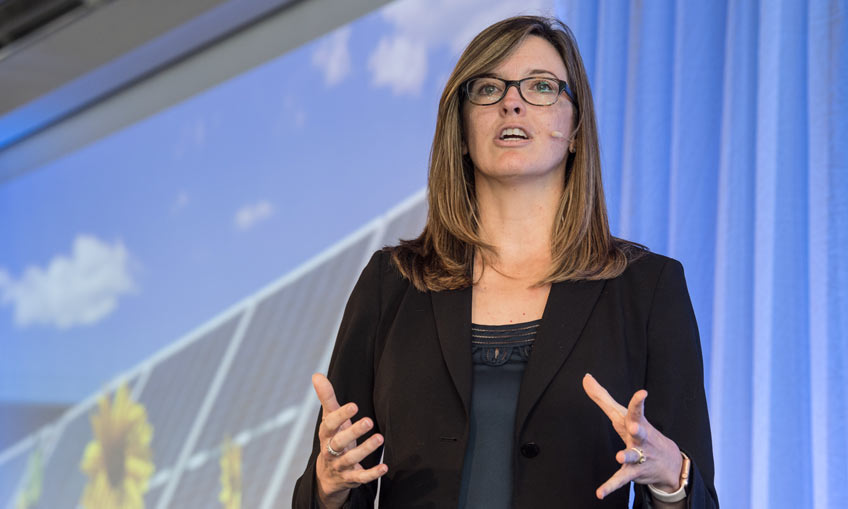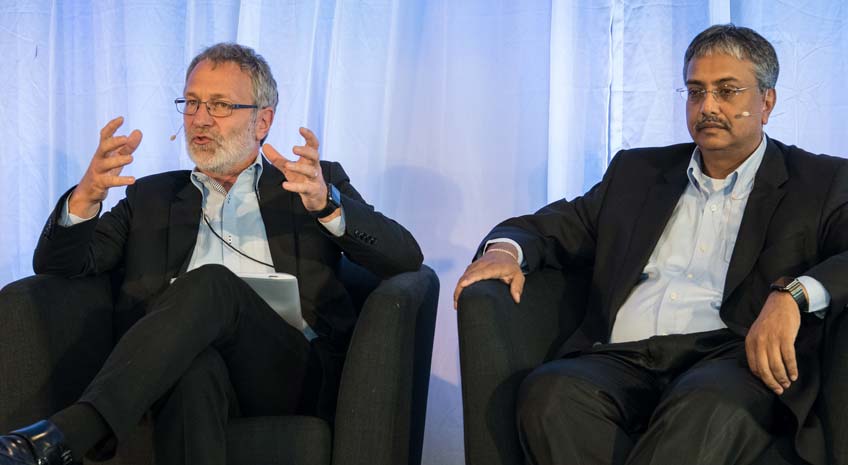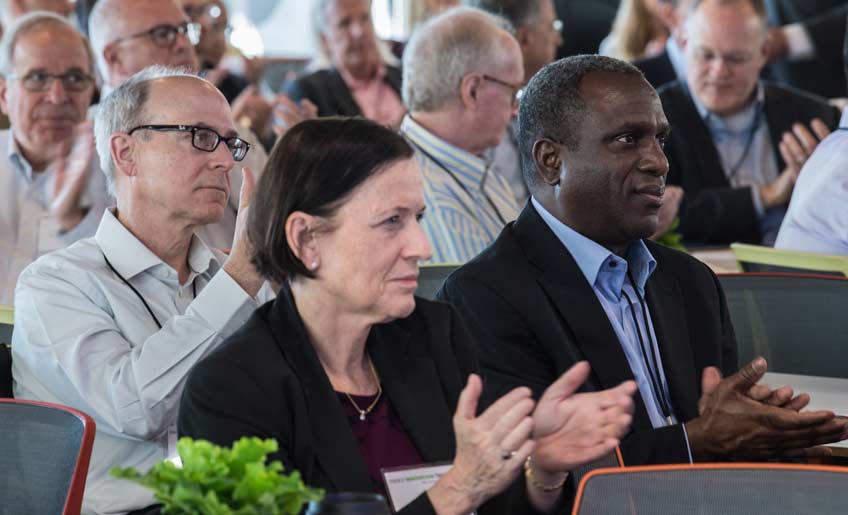Exploring Tomorrow's Energy Solutions, Together
NREL’s 2019 Partner Forum Convenes More than 200 from Industry, Government, and Academia Seeking Common Solutions to Shared Energy Challenges

In 2004, utility giant Xcel Energy had a problem.
Colorado had just passed a constitutionally-based renewable portfolio standard, requiring utilities to obtain 10% of their electricity from renewable energy resources by 2015. But the cost of wind at that time was more than 6.9 cents per kilowatt hour (kWh), and Xcel didn’t know how it was going to reduce costs to meet the requirement without dramatically increasing its rates.
Fortunately, help was just a phone call away.
“First, you need to solve the science,” said Xcel Energy Colorado President Alice Jackson from the stage of the U.S. Department of Energy National Renewable Energy Laboratory’s (NREL’s) 2019 Partner Forum. “Pick up the phone, who do you call? You call NREL.”
Jackson, who gave the event’s keynote address, was one of 200 participants from the private sector, government entities, academia, and more who gathered Aug. 12–13 at NREL’s South Table Mountain Campus in Golden, Colorado.
While their backgrounds were diverse, the entities represented at the forum had one thing in common: They all face very real energy-related challenges in the years and decades ahead—challenges greater than any one company or organization can solve alone.
“When we look at the problems we have, our science is good … that’s the first step,” NREL Director Martin Keller said from the stage while discussing, with ExxonMobil Vice President of Research and Development Vijay Swarup, the organizations’ new $100 million partnership. “But how do we shorten the time to get ideas to the market to make an impact? We team up at an early stage with partners to accelerate time to market.”
The third annual Partner Forum continued a tradition of facilitating engagement with current and potential collaborators—part of NREL’s commitment to expand its impact and gain market insights. The goal is to inform future laboratory research and cultivate the partnerships that will develop and commercialize new technologies to advance the U.S. energy market.
Throughout the event, attendees discussed emerging trends in energy technology, listened, interacted, and networked with other subject matter experts. Speakers prompted attendees with questions, proposed solutions, and attempted to frame problems, all in an effort to shape research foundations and support future energy needs.
“[NREL] sees the future—that there are gaps that need to be bridged—and is strategically positioned to help bridge those gaps,” said Brett Jackson, manager of the Colorado Army National Guard’s Sustainability, Energy, and Engineering Program. “We lean on [NREL] heavily. I would love to see our partnership continue to flourish and see other partnerships come out of this.”
Over the two days of presentations and discussions, several key themes emerged.
Challenge: Coordinating Efforts
Speakers outlined groups of possible solutions to myriad complex energy issues. One uniting thread was a belief that no single solution is likely to deliver scalable solutions to transition the globe to renewable energy.
Rather, a collection of solutions will be necessary. According to Shell General Manager for New Energies Research and Technology Ajay Mehta, “It’s too early to pick winners and losers. There are so many factors—the technology angle, the policy angle—the reality is it’s going to be all of the above.”
Swarup agreed during his dialogue with Keller, pointing out that universities can prove a concept, national laboratories can scale it up and start modeling it, and small companies can demonstrate that the technology is ready to be commercialized.
Given the urgency of energy transitions, the trick is figuring out how to run efforts in parallel, because there isn’t time to run them in series. Swarup broke down what he sees as the best approach to address the list of energy challenges the world is facing.
“The solution set for each sector will be different,” he said. “Developed nations (with existing infrastructure) will have different solutions than developing nations. As you take this monumental problem and break it down to ‘How do I go about doing this?’ it’s nothing different than what we studied in college: Define the problem, break it into subproblems, solve the subproblems, then bring it back up.”
Swarup expanded the principle to include students of a range of disciplines and a diverse workforce.
“You don’t get a degree in energy,” Swarup said. “To take on energy, you need every science and every engineering discipline. We need every ‘ology’ out there.”
Challenge: Looming Renewable Deadlines
Whether by choice or by circumstance, most of the attendees at NREL’s Partner Forum are facing deadlines to implement significant renewable energy transition goals, some just 10 years away.
“We need a sense of urgency,” said Joe Powell, chief scientist at Shell. “We’re hiding behind 2019 saying we’re going to do something about 2030. It’s on us already. We need to be getting the steel in the ground here shortly or 2030 will become 2050. That’s one of the key reasons I’m out here today—to develop that type of partnership opportunity.”
Yuri Freedman, senior director of business development at Sempra Utilities’ SoCalGas, stressed the importance of looking forward by taking attendees back a decade for perspective.
“We are trying to do in 20–30 years what previous energy transitions have accomplished in 100 years,” he said. “Something that was in front of us 10 years ago, we did not see. I always wonder, what is it today in front of us that we’ll be looking back and saying, ‘How did we not see that? It was so blindingly obvious.’ One of the things we don’t see today is how the rapid development and evolution of energy—and changes in supply and demand—can create a challenge for storage. Supply and demand timing never match.”

Challenge: Security and Resiliency
Renewable energy doesn’t only need to be affordable to grow. It also needs to be reliable and protected.
But as we’ve seen, power systems are a frequent target of cyberattacks. Attacking commodity components and industrial control systems requires very specific malware. It takes a very specific knowledge of control systems. Which is why nation states tend to be the source of such attacks.
Defending against them emerged as a significant theme during the Partner Forum.
Annabelle Lee, chief cybersecurity specialist at Nevermore Security, asked organizations to “start thinking like an attacker,” looking at various attack scenarios to find what does and doesn’t apply to them and then prioritize and design their mitigation strategies.
“It used to be protect. Now, it’s detect, respond, recover,” she said. “You need to augment the defensive approach. What are the systems we really want to defend and how are they going to function in a degraded mode? Active defense is the approach.”
According to Dan Prieto, head of strategy at Google Cloud, the fastest hackers can get malware introduced and “past the beachhead” in 18 minutes.
“Let’s look at offense and defense,” he said. “The offense has always seemed to have the upper hand. Defense systems take 45 minutes to evaluate a security alert, many of which are false. Productivity is on the side of the attacker.”
Globally, companies and nations are facing an overwhelming demand for a trained cyber workforce and are attempting to address the critical need through a variety of approaches—but Prieto believes the entire cybersecurity operation model needs to change.
“You will not hire your way out of the problem,” he said. “You will not spend your way out of the problem. Implementing more compliance and standards won’t solve the problem, either. You will not innovate in cyber; you will not bend this productivity curve until you take stuff off your plate.”
Vince Guthrie, utility programs manager at Fort Carson’s Directorate of Public Works, has worked with NREL to help the installation reduce its energy use by 27% since 2005. Cost savings aside, reducing energy use has another important benefit.
“The most important form of energy we have is energy we don’t use,” he said. “The less energy you need, the easier it is to respond and recover.”
Challenge: Storage
According to Bryan Chapman, who does corporate strategic research with the ExxonMobil Research and Engineering Company, “You’re going to need storage, but very large-scale storage. If we can’t solve the storage problem, it might be worth researching processes that can accommodate flexibility in energy generation.”
Powell called storage a “very important portion of the future.” Freedman suggested hydrogen as a solution, saying it can accomplish two tasks: storing surplus energy and powering fuel cell fleets in the transportation sector.
Challenge: Electrons to Molecules
Renewable energy alone won’t solve every challenge. The use of cheap, renewable electricity (instead of fossil fuels) to convert low-energy molecules such as water or carbon dioxide (CO2) into chemicals, materials, fuels, or even energy storage is emerging as an attractive solution. This “electrons to molecules” alternative both reduces reliance on fossil fuels and drives CO2 capture and conversion efforts.
“As a member of the science community, I’m confident we are going to get there,” said Swarup. “The world faces a dual challenging of meeting the energy needs of nine billion people while reducing the risk of climate change. All forms of energy are needed—but new technology options are critical to solve this challenge.”
“We need a different energy mix that is not entirely based on oil,” said Natalya Brooks, senior strategy advisor with Equinor. “The low-cost producer wins, and this is applicable to renewables because they need to be profitable. We can produce a lot of the gas the world will need in the foreseeable future in a better way. A lot of the development on the renewable side is making oil production cheaper, easier, and cleaner. There is a lot that’s moving us in the direction of energy transition. We are also seeing record CO2 emissions. If you look at the global scale, renewables are supplementing oil.”
“What happens if electricity becomes cheaper than thermal heat as an energy source?” asked NREL Associate Laboratory Director for Bioenergy Science and Technology Adam Bratis. “How do we take advantage of that? Using excess, abundant, electricity to build small molecules up. Can you use excess electricity to reduce CO2? What are our options for using electron-based energy rather than heat-based energy? How can we get to renewable methane from CO2? Combine hydrogen and waste CO2 to make renewable methane.”

Challenge: Scale
To solve a global problem, the solution has to be applicable around the world. It must be scalable, and speakers throughout both days of the forum drove home this principle. Swarup acknowledged that scale is often a barrier for R&D at ExxonMobil. Brooks suggested customer pressure and government policies can help with technology scale-up.
“When there are more electric vehicles on the road, you need a new supply chain and more efficient batteries,” she said. “That leads to better and faster development of battery options.”
The challenge of scale has been identified as a difficult one to overcome, but NREL, in partnership with others, has been doing its part to get the ball rolling. Shell’s GameChanger Powered by NREL is designed to fund startups looking for a forum to test ideas. NREL brings the power and capability and allows Shell to decide which technologies have the ability to scale because, as Mehta put it, “We’re hearing it’s a scale, scale, scale problem.”
The Solutions are Out There
While the list of challenges is long, so are the potential solutions. Xcel’s Jackson highlighted this reality as she detailed why the utility called NREL to help with its 2004 mandate problem—faced with a requirement to increase renewable energy generation at a time when the wind power it relied on was prohibitively expensive.
“We doubled down on the technology and figured out how we could tell when the wind was going to blow,” she said. “In the subsequent years, we looked at solar and we’ve been doing the same thing.”
Xcel retired old coal-based assets and replaced that capacity with renewable energy and other resources. It issued new requests for proposals and the resulting bids, according to Jackson, were “the lowest prices this country has ever seen for wind resources, solar resources, and battery storage combined with solar and wind resources.”
Bids for wind fell from 6.9 cents to an average of 1.5 cents per kWh. Bids for solar dropped from 7 cents to as low as 2.5 cents.
“We’ve never been behind,” Jackson said. “We have always been ahead of the curve in adopting renewables on our system and figuring out how to integrate them.”
In the end, Xcel submitted a plan to retire 660 megawatts of coal-fired generation 10 years early and replace it with 700 megawatts (MW) of solar; 1,100 MW of wind; 275 MW of battery storage. The plan also included the purchase of an existing 380-MW natural gas facility. The company did all of this for $215 million less than the cost of adding the 450 MW they needed to have by 2023.
“What that means,” Jackson added, “is by 2025, in the state of Colorado, 55% of the kWh consumed by my customers on the Xcel Energy system will be from renewable energy.”
Today's Middleschooler Could be Tomorrow's Solution
There are plenty more challenges to face in the future. Jackson stressed the importance of industry, government, and academia working together. But took it a step further.
“The answer is not in this room yet,” she said. “The thing that’s going to solve all this is probably stuck in some middle schooler’s head.”
The foundation for answers to our future energy needs sits firmly in the conversations and collaborations of today, and in fostering continued dedication to focused goals through work with small businesses, large companies, universities, and state, local, and federal governments.
Learn more about how to work with NREL through research partnerships, licensing opportunities, and other cleantech support programs.
Related stories:
Last Updated May 28, 2025
